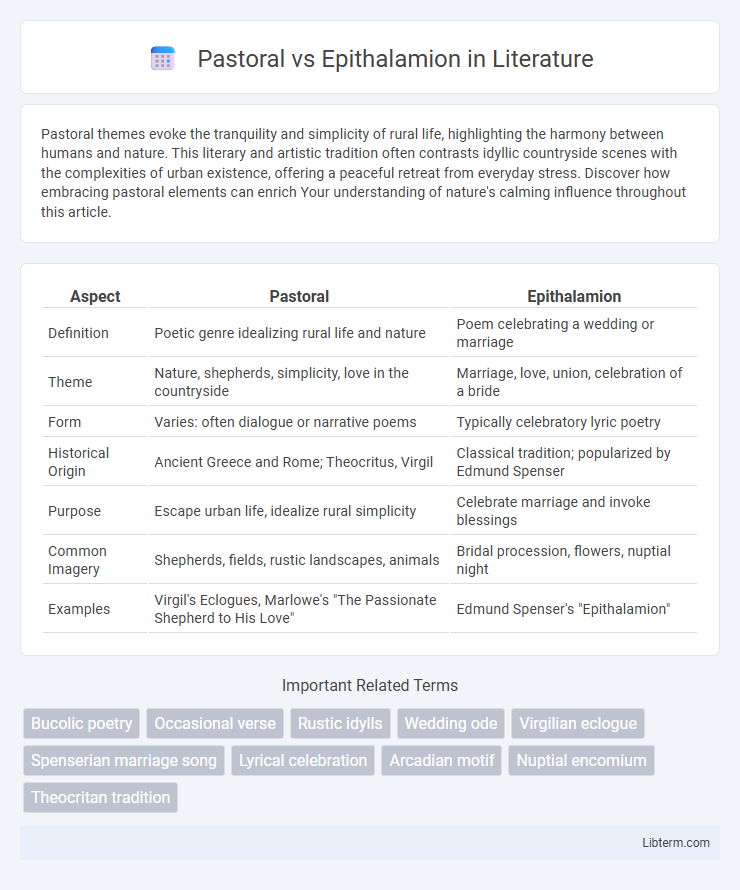Pastoral themes evoke the tranquility and simplicity of rural life, highlighting the harmony between humans and nature. This literary and artistic tradition often contrasts idyllic countryside scenes with the complexities of urban existence, offering a peaceful retreat from everyday stress. Discover how embracing pastoral elements can enrich Your understanding of nature's calming influence throughout this article.
Table of Comparison
| Aspect | Pastoral | Epithalamion |
|---|---|---|
| Definition | Poetic genre idealizing rural life and nature | Poem celebrating a wedding or marriage |
| Theme | Nature, shepherds, simplicity, love in the countryside | Marriage, love, union, celebration of a bride |
| Form | Varies: often dialogue or narrative poems | Typically celebratory lyric poetry |
| Historical Origin | Ancient Greece and Rome; Theocritus, Virgil | Classical tradition; popularized by Edmund Spenser |
| Purpose | Escape urban life, idealize rural simplicity | Celebrate marriage and invoke blessings |
| Common Imagery | Shepherds, fields, rustic landscapes, animals | Bridal procession, flowers, nuptial night |
| Examples | Virgil's Eclogues, Marlowe's "The Passionate Shepherd to His Love" | Edmund Spenser's "Epithalamion" |
Introduction to Pastoral and Epithalamion
Pastoral poetry, rooted in ancient traditions, idealizes rural life and nature through shepherds' idyllic experiences, emphasizing simplicity, harmony, and the natural world. Epithalamion, a specialized poetic form, celebrates marriage, typically composed for bridal ceremonies to honor the union and evoke blessings. Both genres reflect distinct cultural functions--Pastoral as a reflection on nature and rustic existence, Epithalamion as a ceremonial tribute to love and matrimony.
Historical Origins and Literary Background
Pastoral poetry, dating back to ancient Greece and epitomized by Theocritus in the 3rd century BCE, idealizes rural life and nature through shepherds' dialogues, while Epithalamion originates from classical antiquity as a poetic form celebrating marriage ceremonies and invoked through works like Spenser's 1595 "Epithalamion." The pastoral tradition evolved through Roman poets like Virgil, integrating rustic simplicity and allegory, whereas Epithalamia became a staple in Renaissance literature, often blending celebratory and ceremonial themes. Both genres reflect distinct socio-cultural contexts: Pastoral poetry romanticizes the countryside as a symbolic refuge, whereas Epithalamion serves a ceremonial and communal function in matrimonial festivities.
Core Themes of Pastoral Poetry
Pastoral poetry centers on idealized rural life, emphasizing themes of nature's simplicity, rustic innocence, and harmony between humans and the natural world, often portraying shepherds as symbols of purity and contentment. In contrast, epithalamion is a celebratory poem or song dedicated to a bride and groom, focusing on marital union and fertility. The core themes of pastoral poetry include the contrast between the innocence of rural life and the corruption of urban existence, the exploration of love and loss in a bucolic setting, and the nostalgic longing for a peaceful, untroubled life.
Defining Features of the Epithalamion
The Epithalamion is a classical poetic form specifically designed to celebrate a wedding, characterized by its joyful tone, vivid imagery of bridal rituals, and invocation of blessings for the couple's union and future happiness. Unlike the broader and more nature-focused Pastoral, which idealizes rural life and shepherds, the Epithalamion centers on themes of marriage, love, and fidelity, often structured in multiple stanzas that correspond to different parts of the nuptial ceremony. Its defining features include direct address to the bride and groom, allegorical references to divine protectors, and an optimistic reflection on the transformative power of love within a social and spiritual context.
Nature and Setting: Idealized Landscapes vs. Wedding Celebrations
Pastoral poetry features idealized landscapes that celebrate the simplicity and tranquility of rural life, often portraying shepherds in serene natural settings. Epithalamion centers on wedding celebrations, depicting vibrant, joyous scenes filled with symbolic references to fertility and union within a festive environment. Both genres utilize nature, but pastoral emphasizes peaceful, timeless countryside, while epithalamion highlights dynamic, ceremonial contexts tied to marriage rituals.
Symbolism and Imagery: Rural Life vs. Nuptial Rites
Pastoral poetry employs symbolism and imagery rooted in rural life, often depicting serene landscapes, shepherds, and nature as metaphors for simplicity and harmony. Epithalamion, by contrast, uses vivid imagery related to nuptial rites, such as bridal processions, floral adornments, and ceremonial celebrations, symbolizing love, union, and fertility. The pastoral genre idealizes the natural world, while epithalamion emphasizes the sacred and festive elements of marriage rituals.
Famous Exemplars in Literary Tradition
Pastoral poetry, exemplified by Theocritus's "Idylls" and Virgil's "Eclogues," idealizes rural life with shepherds and rustic settings, influencing Renaissance poets like Edmund Spenser and Christopher Marlowe. Epithalamion, a genre celebrating nuptial ceremonies, is famously represented by Edmund Spenser's "Epithalamion," which intricately blends personal emotion with mythological allusions. Both forms showcase distinct cultural values through their canonical works, emphasizing pastoral simplicity versus the celebratory nature of marriage in literary tradition.
Emotional Tone and Purpose
Pastoral poetry evokes a serene, idealized vision of rural life, often conveying tranquility and nostalgia to celebrate nature's simplicity and harmony. Epithalamion, by contrast, expresses exuberant joy and anticipation, serving as a poetic tribute to marriage and the union of lovers. The emotional tone of pastoral is calm and reflective, while epithalamion is vibrant and celebratory, each tailored to its distinct purpose.
Influence on Later Literature and Modern Adaptations
Pastoral and Epithalamion genres have profoundly shaped later literature by inspiring themes of nature, love, and celebration, often reflected in Romantic and Victorian poetry. Pastoral motifs influenced modern adaptations through idyllic rural settings and idealized depictions of rustic life in novels, films, and theater. Epithalamion's ceremonial and nuptial elements continue to inform contemporary wedding poetry and songs, preserving its celebratory essence in modern cultural rituals.
Comparative Analysis: Key Differences and Similarities
Pastoral poetry idealizes rural life, emphasizing nature, shepherds, and simplicity, while epithalamion celebrates marriage through lyrical and festive themes. Both genres employ vivid imagery and classical motifs, yet pastorals evoke tranquility and harmony with nature, whereas epithalamions convey joy and matrimonial blessings. The key difference lies in their thematic focus: pastoral centers on rustic existence, epithalamion on nuptial celebration.
Pastoral Infographic

 libterm.com
libterm.com